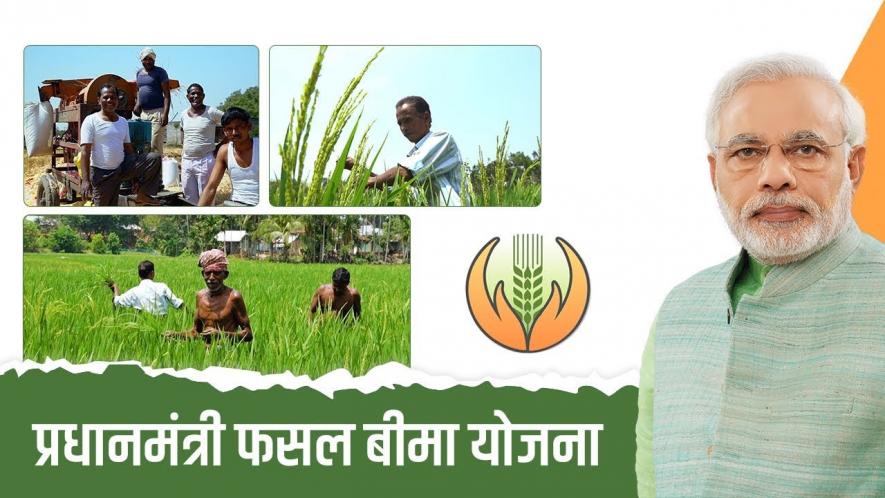Corporate Sector Makes Landslide Profits from Modi’s Flagship Agri-Insurance Scheme

New Delhi: Five years after Prime Minister Narendra Modi launched India’s flagship scheme to compensate crop losses of farmers, the initiative has resulted in a win-win situation for corporate insurance firms which have not only made windfall profits but have also abdicated several responsibilities entrusted upon them in lieu of entering the sector.
Many of the private insurance firms have made profits of 50 to 70%, as a difference between gross premium collected and insurance claims paid, in the Pradhan Mantri Fasal Bima Yojana after it was launched in 2016. The profits have been raked in from government revenues that were transferred directly to the firms apart from premiums that have been collected from farmers.
These findings are part of a report, titled Pradhan Mantri Fasal Bima Yojana – An Evaluation which was tabled on August 10 by the Parliamentary Standing Committee on Agriculture. Modi government told the Committee that it has no records whatsoever of grievances that farmers have raised against rejection of claims or non-settlement of dues.
At present, the scheme is being implemented in the country by 13 private sector firms along with all five state-owned insurance companies including the Agriculture Insurance Company of India Limited. However, while private firms have raked in huge profits, those in the public sector have doled out almost all the premium collected by them towards insurance claims. The Agriculture Insurance Company of India Limited, which controls the major share of the crop insurance market, has been able to make a profit of approximately 17%.
As per provisional figures (insurance claims for the year 2019-20 had not been finalised at the time that the Committee collected the data), in the period 2016-20, the Agriculture Insurance Company of India Limited had paid out claims of Rs 26,874.60 crores from the gross premium of Rs 32,429 crores that it had received. The profit of state-owned United India Insurance Company Limited was marginal at around Rs 491 crores. It received a gross premium of Rs 4,553.38 crores and paid out Rs 4,062.03 crores as insurance claims. Similarly, the National Insurance Company Limited has made a modest profit of around Rs 70 crores having paid out claims worth Rs 2,514.77 crores from the sum of Rs 2,574.34 crores that it received as gross premium.
The remaining two public sector insurance companies have actually incurred losses. The New India Assurance Company Limited paid out Rs 5,145.22 crores towards insurance claims as against the gross premium of Rs 4,660.31 crores that it received. Again, Oriental Insurance Company Limited collected gross premium amounting to Rs 3,893.17 crores but paid out insurance claims totaling Rs 4,305.66 crores.
Now, sample the profit margins of some of the private sector insurance firms! The Royal Sundaram General Insurance Company Limited has, for the period of 2017-20, collected gross premium amounting to Rs 1,157.82 crore and paid out insurance claims worth Rs 307.36 crore. A whopping profit margin of nearly 74%! Bharti AXA General Insurance Company Limited has collected gross premium worth Rs 1,575.42 crores in the time period 2017-20 during which it has doled out Rs 438.80 crores towards insurance claims thereby keeping a profit margin of around 72%.
The Future Generali India Insurance Company Limited has managed a profit margin of around 61% with Rs 1,532.84 crores collected as gross premium and Rs 599.09 crores given out as insurance claims during the three financial years that it has been in the central government’s crop insurance business scheme, that is, 2016-17, 2018-19 and 2019-20. During the financial years from 2016-17 to 2019-20, the Reliance General Insurance Company Limited has made a profit of 58% with Rs 6,150.22 crores collected as gross premium and Rs 2,580.56 paid as insurance claims. Similarly, the IFFCO-Tokio General Insurance Company Limited has made a profit of 46%, having collected Rs 6,136.28 crores as gross premium and having given out Rs 3,320.26 crores as insurance claims in between 2016 and 2020.
The case of Cholamandalam MS General Insurance Company Limited, another private firm, is an aberration in this list since it exited the crop insurance business in 2019-20 after suffering losses in the previous three years. As against a gross premium of Rs 1,277.50 crores that the private firm collected in between 2016 and 2019, it paid insurance claims worth Rs 1,325.30 crores. None of the other private firms have incurred losses in the programme.
The government’s own response to the allegation that the scheme has resulted in undue enrichment of private insurance firms is hardly convincing in nature. The Union Ministry of Agriculture and Farmers’ Welfare told the Committee:
“ … all the Insurance Companies except the Agriculture Insurance Company of India Ltd. are doing other insurance business like motor, fire, aviation insurance etc. and the difference between premium collected and claims paid is not the margin/profit for the insurance companies. The cost of reinsurance and administrative cost totaling 10% to 12% of gross premium also has to be borne by the Insurance Companies. Further, out of the total crop insurance business under the Scheme more than 50% is shared by the 5 Public Sector Insurance Companies including Agriculture Insurance Company of India Ltd.”
Almost identical reasons had been put forth by Union Agriculture Minister Narendra Singh Tomar on the floor of the Rajya Sabha more than a year ago when he countered allegations of undue enrichment of the corporate sector at the cost of the public exchequer through the use of this scheme. “Insurers save premium in good seasons and pay high claims in bad years from savings made in the good years”, Tomar had told the Parliament in defence of the allegation.
“The entire insurance industry works on the basis of this premise. But it is pretty evident that this scheme has resulted in undue enrichment of insurance firms. Through this scheme, if the government wanted to bring all stakeholders on a single platform that is to be managed by insurance firms, why was not the entire exercise conducted through public sector companies only?” asked Ashish Ranjan, an expert on the farm sector.
Surprisingly, despite clear provisions of the scheme, the Union government has not yet conducted a performance evaluation of the insurance firms, five years down the line. The Union Agriculture Ministry informed the Committee, nevertheless, that an evaluation procedure has been initiated. A member of Jan Jagran Shakti Sangathan, a Bihar-based trade union of unorganised workers, Ranjan further added: “This scheme, besides, has not benefitted share croppers at all, who have no documentary proof whatsoever over the land which they till. Share croppers, though they comprise a significant proportion of the agricultural community, have been left out of the scheme while insurance firms have benefitted.”
On the other hand, despite the profits, insurance firms have not yet set up offices nor deployed officials at the Tehsil level in most districts of the country resulting in hardships to farmers. As required under the operational guidelines of the scheme, insurance companies are required to open a functional office at the Tehsil level in each district, deploy at least one agent at the Block level in the allocated districts and also post an Agriculture Graduate in each district to expedite insurance claims and ensure quick redressal of grievances.
Furthermore, the Committee also reported that representatives of insurance firms hardly ever attend district-level meetings held every quarter under the chairmanship of the local Lok Sabha MP to review progress of government schemes. There exists a provision in the operational guidelines of the scheme by which farmers are entitled to penalties at the rate of 12% interest rate per annum, to be paid by the concerned insurance company, on account of delay in settlement of claims beyond 10 days of the prescribed cut-off date. However, in the absence of any time-frame within which the claims are to be settled, the Committee has noted, farmers are left at the mercy of insurance companies and are forced to take recourse to lengthy court procedures, thereby adding to their own misery.
That’s not all. The scheme, which had been launched by Modi with great pomp and show, does not entail upon insurance firms to invest a sou from their massive profits towards corporate social responsibility activities, not even in the districts in which they make windfall gains.
As per the report, it is not private insurance firms alone that have committed dereliction of duty in the implementation of the provisions of this scheme. A three-tier grievance redressal mechanism—at the Taluka, district and state levels—has been envisaged in the scheme for settling complaints of farmers regarding insurance settlement delays or rejections. However, only three states—Rajasthan, Maharashtra and Tamil Nadu—have set up the three-tier system. Interestingly, none of these three states are ruled at present by political parties affiliated to the BJP.
“15 States/Union Territories have notified both District & State level grievance redressal committees in their respective States. Further, 4 States and 1 State has also constituted SGRC and DGRC respectively. Data on types of grievances resolved by these committees is not available,” the Committee has noted in its report.
For calculation of crop loss to settle insurance claims by farmers, the unit of insurance is not individual plots of land but a village panchayat as a whole. This calculation is normally done manually through crop-cutting experiments that are conducted in the presence of officials from the insurance firms as well as the local district administration. The government has introduced modern technology to assess crop yields, which could also minimize irregularities, but it has so far been conducted on a pilot basis only.
Is there a nexus existing between officials of insurance firms and lower-level district administration officials which has resulted in low settlement of claims by companies belonging to the private sector? The Union Agriculture Ministry has itself told the Parliamentary Committee that there is lack of co-ordination between government departments and insurance firms as far as calculation of yield data for crop loss claims is concerned. This has resulted in delays in settlement of claims in many instances.
“In the last two years, the Union government has taken a number of steps to modify the programme guidelines so as to improve the functioning of the scheme. Eight reputed institutions have been engaged to conduct pilots in 100 districts for estimation of crop yield through the use of satellite data, UAV, Internet of things, artificial intelligence and machine learning. The results of these pilots should be urgently analyzed and released to the public. If they are found successful, such technologies may be used in more districts in Rabi 2021-22,” former Union Agriculture Secretary Siraj Hussain told the Newsclick
The writer is an independent journalist.
Get the latest reports & analysis with people's perspective on Protests, movements & deep analytical videos, discussions of the current affairs in your Telegram app. Subscribe to NewsClick's Telegram channel & get Real-Time updates on stories, as they get published on our website.
























